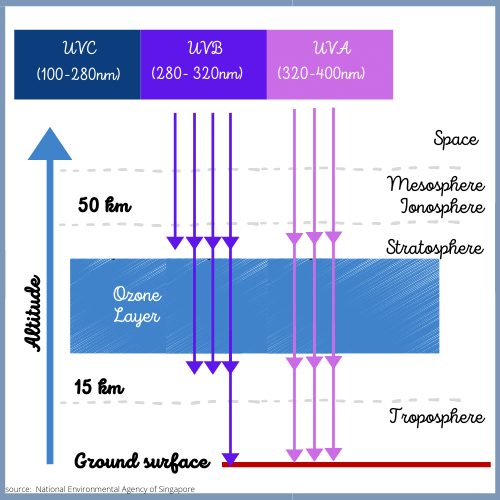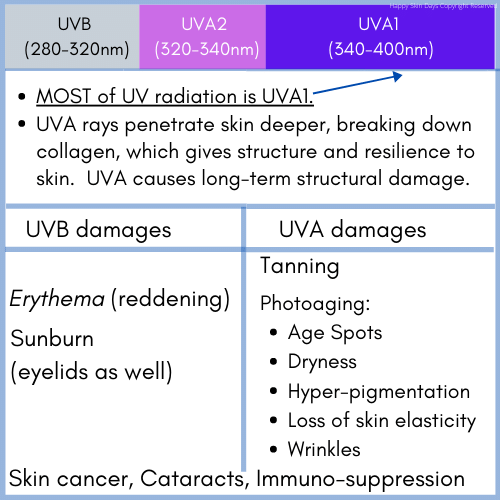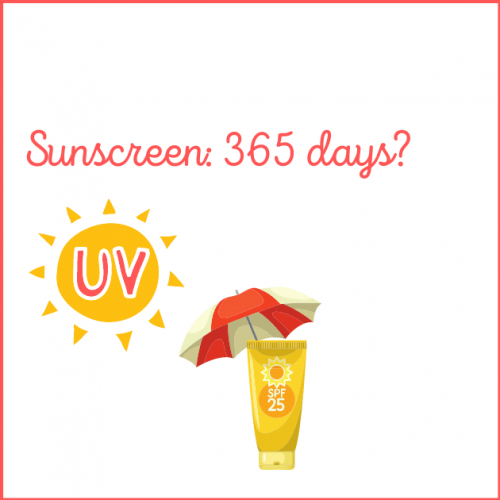On being asked whether or not they are using sunscreen, the standard operating familial response is, “the sun is not shining, so no.” Frankly, cloud cover is not such a disaster when judging whether or not to use sunscreen. But solar UV radiation can still be very intense despite cloud cover. This is the UV Index for Singapore (where it is invariably cloud) and anything above 3, suggests sunscreen use.

So for 365 days of the year you should be using sunscreen in Singapore!
Do I wear sunscreen every day?
Yes, during winter and summer, irrespective of whether I spend time indoors or outdoors. Let me explain why:
- My skin is photo-aged (which translates as I have excessive pigmentation for my age) caused mainly by excessive exposure to solar UV radiation. Be in no doubt that photo-aging is principally caused by low-energy UVA radiation. This premature or photoaging is cumulative and I do not want to (e.g.) take a retinol to partially reverse this. The pigmentation on my face, like my greying hair, tell a story and its my story. I do not wish to erase them.

- As sun damage is cumulative (see also Myths about sun protection) and for about six months of a year I will intentionally spend 2-3 hours outdoors, I use sunscreen to counter further photo-damage to my skin from further photo-damage. Remember that sunscreen is not a 100% bullet-proof mechanism – it helps, but it does not block all UV radiation and nor does it reduce existing photo-damage.
Admittedly, I don’t wear an SPF 50 every day, but I do wear an SPF 30 with very strong protection against UVA. (See also My Top Sunscreen recommendations)
Today’s blog
It’s simply going back to basics explaining:
1) UV radiation: UVA and UVB radiation
2) Deleterious effects of excessive exposure to UV radiation
3) Skin aging and UV radiation
1) UV radiation: UVA and UVB
The sun emits electromagnetic radiation of different wavelengths, and is the main source of Ultra Violet radiation (UVR). (Note that the amount of UVR reaching the earth’s surface is increasing yearly).
UVR is of 3 types: UVC , UVB and UVA.

No UVC enters the earth’s atmosphere.
UVB radiation (280nm-320nm) has a shorter wavelength and is more energetic. Approximately 90-95% of UVB radiation is absorbed in the atmosphere.
UVA radiation (320-400nm): Most of UVA (about 95%) reaches the earth’s surface. UVA is of two types and UVAI is approximately 75% of this.
Therefore the bulk of UV radiation is UVAI radiation.
Note that because UVAI is of longer wavelength it also penetrates deeper layers of the skin…
2) Deleterious effects of excessive exposure to UV radiation

Specific deleterious effects of over-exposure to UVB radiation that I like to highlight include: reddening of the skin (erythema), sunburn and skin cancer. For UVA, the corresponding over-exposure includes photoaging (hyper-pigmentation, age spots, loss of skin elasticity, wrinkles and dryness). Both cause DNA damage, immuno-suppression and cataracts (in our eyes).
3) Skin aging and UV radiation
It is scientifically well-established (given how many studies and empirical data that there is on this subject) that UV radiation contributes to skin aging – as much as 80%. Noteworthy points made in relation to photoaging are:
i) All layers of the skin are affected by photoaging

ii) All UV wavelengths: UVB and both types of UVA contribute to photoaging.
iii) Krutmann et al write ” photoaging of human skin mainly results from daily exposure to non-extreme, low doses, which does not cause any visible changes at times of exposure while leading to biological changes and that UVA rays and in particular, long wavelength
UVA1 is a major contributor.”
iv) Evidence suggests that regular use of sunscreen can delay photoaging…
3) How do I know when to wear sunscreen?
On the basis that during daylight hours, there is in some shape of form, “non-extreme, low doses” of low energy UVAI and that photoaging occurs over many years, the answer you should wear sunscreen every day. I am not saying that you should wear an SPF 100 especially during a lockdown, but an SPF 30 once a day should be part of your regular skincare routine.
We can make this more or less complicated by looking at the Solar UV Index and factors that affect the intensity of UV radiation – but don’t get side-tracked by all the noise out there about excessive sunscreen use etc.
See this blog on what the UV Index is and this blog on the Factors that affect the intensity of UV radiation
Sources and uses: Jean Krutmann, Anne Bouloc, Gabrielle Sore, Bruno A. Bernard, Thierry Passeron, The skin aging exposome, Journal of Dermatological Science, Volume 85, Issue 3, 2017, Pages 152-161
See also
